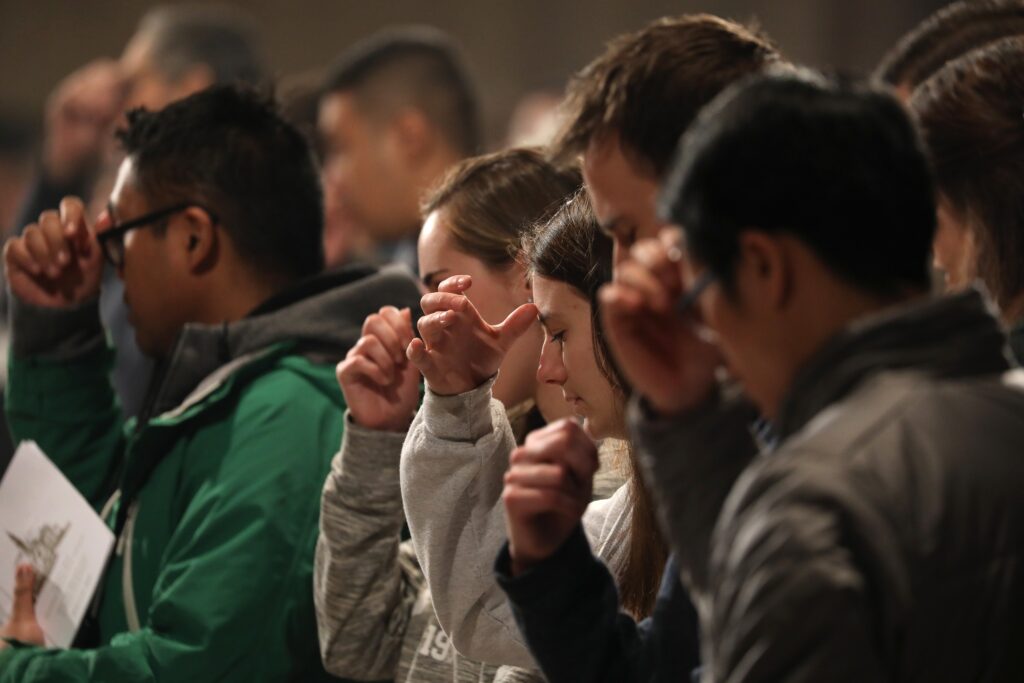 I was a shy, nerdy child who steered away from being the center of attention. I preferred silence to noise, and my own company to large parties. My true passion in life was reading. I could hole up alone in my room for hours, devouring book after book.
I was a shy, nerdy child who steered away from being the center of attention. I preferred silence to noise, and my own company to large parties. My true passion in life was reading. I could hole up alone in my room for hours, devouring book after book.
So when my mom gave me the option of going to Sunday school or reading in the pew during Mass, the choice was easy! Usually, I would be engrossed in my book and oblivious to what went on around me, but one day, I lifted my eyes up during the service.
The priest was making the sign of the cross on his head, lips, and heart. Then he started the Gospel proclamation. I was transfixed. He was reading, and people were listening. It was quiet, and God was speaking. The moment felt holy and magical. It drew me away from my solitary activity and into the communal experience of God’s presence. And it all started with the priest crossing himself three times.
RELATED: Catholic Mass Isn’t What I Thought It Would Be — It’s So Much More
Even when I journeyed away from the Catholic Church in high school, I never forgot the power of those crosses over the head, lips, and heart.
Eventually, I married a Protestant man with a Master of Theology. One day, he saw me open my Bible and slowly make three small crosses. He asked me what I was doing, and I responded eagerly, “Oh it’s this Catholic thing! They do it before the Gospel is read at Mass. I’m asking for God’s word to be on my mind, on my lips, and in my heart.” (I was exhilarated to know something about faith that he didn’t!)
My husband’s question prompted self-reflection: Why had I carried this tradition with me for so long? Where does it come from? How did it become part of Mass? What is its true meaning?
My research yielded this beautiful interpretation of the practice: “We cross our forehead so that the Word of God may be in our thoughts and purify our minds. We cross our lips so that our speech may be holy and incline us to share the Gospel with others. And we cross our hearts to invite God to strengthen our love for him and others. All of this is so that we might know, proclaim, and love Jesus Christ all the more.” What a perfect summary of the purpose behind my deceptively simple three cross prayer!
LISTEN: Why Do We Bless Ourselves During Mass?
Beyond understanding the meaning of this gesture, I wanted to know its history. I learned that the first record of making the sign of the cross before the Gospel proclamation was in the ninth century. Benedictine Monk Remigius of Auxerre (d. c. 908) wrote that the congregation signed their foreheads as the deacon signed his forehead and breast.
Later, this practice was solidified by Pope Innocent in the 11th century. He declared that the deacon would make the sign of the cross on the Bible, and then together with the congregation, everyone would sign their foreheads, lips, and chests.
This ancient tradition was handed down from the time of Remigius to me. That’s over 1,100 years and untold billions of people approaching God’s word with this same gesture. These crosses connect me to my ancestors of faith, but their power and purpose don’t stop there.
When I served as a Jesuit volunteer in Tanzania, I started going to weekly Mass once again. The service was in Swahili, and I was out of Catholic shape. So I often felt lost: sitting when others knelt or mumbling under my breath when I couldn’t remember the correct responses. But then, right before the Gospel, came my shining moment. Together with my Tanzanian brethren, I made the crosses over my head, lips, and heart. The gesture grounded me and connected me to the people around me. Even if I couldn’t understand the words, we stood as one body before our God and King.
RELATED: What Missionary Work Taught Me About Longing for Home
The three cross prayer reminds me that encountering God is not a solitary activity. When I make that gesture, I am not the first, the last, or the only person praying for God’s word to be on my mind, lips, and heart. Instead, I am joined by believers around the world and throughout the generations in our collective desire to know God. And even if we have different skin tones or customs, wear different clothes or speak different languages, we are united as God’s children. We are not alone, and we truly are more alike than we are different.
I am still nerdy and shy with a preference for silence. I still love to read alone in my room. But when I open my Bible and make those three crosses, I am no longer alone. That gesture unites me with my brothers and sisters in Christ across time and space. Together as one holy, catholic and apostolic family, we ask our Father to keep his words on our minds, on our lips, and in our hearts.




